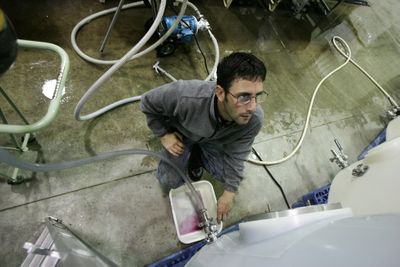Warming a win for winemakers
State’s growers adapting to climate change

When Rick Small began growing wine grapes in the 1970s as a third-generation farmer in Lowden, Wash., winemaking in the state was largely an experimental venture.
“I wasn’t sure that it was going to be successful,” said Small, co-owner of Woodward Canyon Winery. “I just was excited about the possibilities.”
Today, Washington is second to California in wine production in the United States, and the Washington wine industry contributes nearly $3 billion to the state economy.
Warming trends have helped make the thriving Northwest wine industry possible, at least one expert believes.
“I don’t think that the Northwest was very suitable for wine grapes 50 years ago,” said Gregory V. Jones, a professor and climatologist at Southern Oregon University who specializes in viticulture and enology research.
In a 2003 study, he and a co-author found the average temperature of 27 major wine regions in the world increased by about two degrees Celsius between 1950 and 1999, including Eastern and Central Washington. He predicted temperatures will increase another 2 degrees between 2000 and 2049.
“Today, the climates are more suitable to wine grape production in the Pacific Northwest than ever,” Jones said.
While experts believe climate change may hurt the region’s natural habitats, reduce energy production and boost wildfire frequency, local wine grapes have emerged as a beneficiary of warmer weather. Farmers, however, disagree on how much of an effect these trends will have on the industry.
Small, chairman of the Washington Wine Commission, has seen considerable changes since he first began farming, though he isn’t sure it’s global warming.
“Since 1999 to 2000,” Small said, “it’s been ridiculously warm – warmer than I’ve ever seen before.”
Temperatures and tastes both contribute
But farmers have also toyed with different wine grape varieties and tested to see what thrives in the region, said Markus Keller, professor of viticulture at Washington State University’s extension center in Prosser.
In the years following the Washington wine industry’s commercial start in the 1970s, the predominant grapes were white varietals, such as chardonnay and riesling. In recent years the market has shifted toward reds, such as cabernet sauvignon and merlot, because of consumer preferences for darker wines.
To address climate change, Woodward Canyon is experimenting with planting grapes on north slopes instead of south slopes, Small said. Other farmers may plant on higher elevations or on land closer to the Cascades or Canada.
“If things continue to change … what we now know to be suitable won’t be suitable in the next 50 years,” said Jones, the professor at Southern Oregon.
He doesn’t see that as a problem, though.
“People in agribusiness adapt all the time,” he said. “They’re more resilient to climate change than any other sector in society. … The people growing wine grapes have been adapting all along.”
Uncertainty among farmers
Dick Boushey, co-owner of Boushey Vineyards near Grandview, Wash., isn’t concerned about a warming trend.
“We’ve had some extremely hot years in the last 10 years, but we’ve also had extremely cold years,” Boushey said. “I don’t know what a normal year is.”
Though 2008 is said to be a cooler year, Keller said, the warm temperatures of the past few years have tricked observers into thinking this more average year was cold.
In Washington, a relatively new wine region that has only had a serious industry for 30 years, grape growers are flexible, which will help combat any climate changes, Boushey said.
But Kent Waliser, general manager of Sagemoor Vineyards near the Tri-Cities, said that predictions of climate change have had little effect on the way grape growers perform their trade.
“We’re not changing future plantings based on what people think might happen,” he said.
Market demands, safety and pest management are more immediate concerns, Boushey said.
“What we’re doing is helping to prepare for climate change by using less water,” he said. “We’re more ready for this than maybe the rest of the world.”
Still positive about the industry
In the past 50 years, snowpack in the Cascade Mountains has decreased by as much as 30 percent, scientists say, and could continue to decline. For farmers like Boushey, that’s a big concern. He depends on Yakima River drainage, so a smaller snowpack could reduce the water his grapes get.
So far, declining snowpack has not hurt vineyards because precipitation has remained the same, Keller said. In the future, however, more of that precipitation will come in the form of rain instead of snow.
Because of this, the water supply from snow might flow to the crops in the spring instead of the summer months when it’s needed, Jones said.
Boushey asserts that vineyards use half to one-third the amount of water used for other crops, such as pears and apples.
“Wine grapes will be the last to go,” Boushey said.
Furthermore, the wine industry benefits from its attachment to the tourism and hospitality industries, allowing it to remain an economically strong crop even if other crops suffer, said Wade Wolfe, co-owner of Thurston Wolfe winery in Prosser.
Although farmers know there are great challenges ahead, they remain positive about the thriving wine industry they have helped foster.
Boushey said Washington has a real advantage over other wine producers, such as those in Europe, because in older wine regions, farmers are restricted to growing particular varietals, as they have for centuries.
“Here, we’re not tied to that, we can grow any varieties anywhere,” he said. “We’re not bound by tradition like some of these areas.”